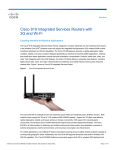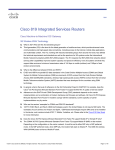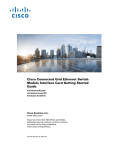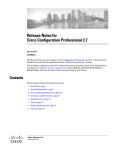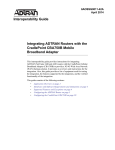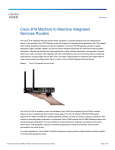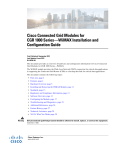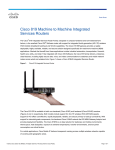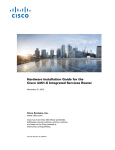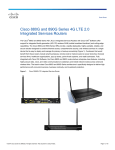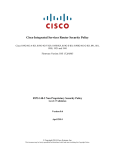Download Cisco CAB-L400-50-TNC-N= coaxial cable
Transcript
Guide
LTE Antenna Guide
Cisco Integrated Services Router
(ISR G2) and Connected Grid Router
For All Verizon Wireless 4G Services
Revision 3.7
December 2014
© 2014 Cisco and/or its affiliates
All rights reserved. This document is Cisco Public Information.
Page 1 of 22
Antenna Guide for ISR and CGR with Verizon Wireless 4G LTE
Introduction
LTE offers a valuable last mile access option for remote locations, kiosks, temporary sites, vehicle communications
and machine-to-machine applications. Benefits of 4G wireless access include reach, mobility, cost (depends on usage
and plan) and performance. This document is focused on Cisco ISR LTE performance based on signal quality due to
antenna type and placement. The information is appropriate for Cisco 1900, 2900, 3900 with EHWIC-4G-LTE-V,
C819G-4G-V, and CGR2010 with GRWIC-4G-LTE-V. This document is organized in the following fashion:
●
Very brief guidelines for antenna selection and placement
●
General guidelines for antenna selection, placement and installation
●
Detailed guidelines for antenna selection, placement, installation, and confirmation
●
Sample configuration for retrieving LTE status, radio signal and ping results via text message
●
Frequently Asked Questions
Very Brief Guidelines for Antenna Selection and Placement
1.
All platforms ship with quantity 2 4G-LTE-ANTM-D indoor dipole antennas. Always connect both antennas.
2.
Antennas should always be placed more than 17” apart. The only way to do this is to use an antenna cable with
at least one of the antennas. At least one 10’ cable with base (4G-AE010-R) ships with every Cisco LTE device.
(C819G-4G-V units shipped before October 2013 may not include a cable; one can be purchased separately)
3.
If after confirming a correct software image, software configuration, a properly enabled SIM, and connected
antennas, there is no LTE connection or low performance, review the general guidelines that follow. For software
image and configuration recommendations, see the Verizon LTE deployment guides at
www.cisco.com/en/US/products/ps5949/products_installation_and_configuration_guides_list.html
4.
Use of a separate “bridge” LTE device added to an ISR (instead of an ISR LTE interface with good antenna
placement) is not recommended. LTE bridges connect to an ISR via Ethernet and have these characteristics:
a.
Allow the use of inexpensive unshielded twisted pair cabling instead of a low loss antenna cable
b.
Negatively affect the ability of the ISR to know the actual status of LTE WAN connection
c.
Impair remote site management (visibility into the LTE specifics: RSSI, RSRP, RSRQ, SINR)
d.
Impair troubleshooting (no remote DM Logging, no output detail from IOS LTE modem status)
e.
Disallow LTE modem tuning and control from the ISR (e.g. no automation of those functions)
ISRs have indoor and outdoor antenna options/SKUs that allow the antenna to be placed up to 75 feet away,
while still providing the advantages of a single integrated solution.
© 2014 Cisco and/or its affiliates
All rights reserved. This document is Cisco Public Information.
Page 2 of 22
Antenna Guide for ISR and CGR with Verizon Wireless 4G LTE
General Guidelines for Antenna Placement, Selection, and Installation
There are some common issues for not achieving an LTE connection or for poor LTE performance. These should be
checked, and if needed, corrected:
1.
The appropriate IOS version is not installed, or the configuration used is affecting data connection. Please
see the appropriate deployment guide at
www.cisco.com/en/US/products/ps5949/products_installation_and_configuration_guides_list.html
2.
An Internet LTE connection becomes active for less than a minute, then disconnects, reconnects,
disconnects again, continuously (log messages such as “Cellular interface is up”…down…up…down). All
packets leaving the ISR onto the Verizon LTE network must have the ISR cellular interface's IP address as
the source address. Non-conforming packets are IP packet violations and the LTE network will disconnect
the ISR cellular interface. This is a configuration issue resolved by using the appropriate guide from the link
above (all traffic NAT’d, or encapsulated in a VPN tunnel).
3.
The SIM is not seated properly. Checked with “show cellular x hardware”, to ensure that the MSISDN and
ICCID are seen. If not seen after 10 minutes after bootup: Power off ISR, remove and reinstall SIM, power on
ISR, await boot-up, and check again.
4.
The SIM is not provisioned properly or is not enabled. One way to check to so put the SIM in a working 4G
device. Another check is to review the output from “show cell x network” and ensure that “no service” is not
seen (shown below, means no attach to the IMS APN, which is needed before the data APN attach can
occur. The Current Service Status should be “Normal”).
Network Information
===================
Current System Time = Tue May 13 15:11:20 2014
Current Service Status = No service
5.
The LTE service is MPN or Public/Static, and the appropriate APN is not set on the LTE modem. The value
is seen via IOS enable mode command “show cell 0/x/0 profile” (x = eHWIC slot #0) or “show cell 0 profile (for
C819G-4G-V). Please see the MPN planning guide or Public/Static IP guide for how to correct.
www.cisco.com/en/US/products/ps5949/products_installation_and_configuration_guides_list.html
6.
The IMS profile is set to IPv4 (see profile 1 from “show cell x profile” command). For instructions to reset to
IPv6, open a Cisco TAC service request. The proper output is shown below.
Profile Information
====================
Profile 1 = INACTIVE **
-------PDP Type = IPv6
Access Point Name (APN) = vzwims
© 2014 Cisco and/or its affiliates
All rights reserved. This document is Cisco Public Information.
Page 3 of 22
Antenna Guide for ISR and CGR with Verizon Wireless 4G LTE
7.
A single antenna is connected, and that antenna connected to the M1/DIV port instead of the M0/MAIN
port. An LTE connection will usually not be made. Both antennas should be installed.
8.
A single antenna is connected to M0/MAIN port (no antenna connected to M1/DIV port). This will affect
downlink performance. Both antennas should be installed.
9.
The antennas are not securely tightened. The antennas may not remain vertical (the appropriate position for
a dipole) or the loose connection will yield intermittent or lower signal quality all connectors should be tight.
10. Both antennas are directly connected to the ISR. This may reduce LTE performance of the ISR. At least one
antenna should be connected via an extension cable (supplied) and antennas separated by 18 inches.
11. Antennas not positioned for optimal reception. Antennas should be placed outside any metal or thick walled
(concrete, brick, etc.) enclosure, preferably either close to a window or on a higher floor (e.g. not in a
basement). The appropriate antenna installation guide should be reviewed and followed (see next item).
12. The Cisco antenna was not installed as recommended. Please see the following installation guide:
www.cisco.com/en/US/docs/routers/access/interfaces/ic/hardware/installation/guide/EHW IC34G3LTEHW .html
13. Antennas used are not 4G-compatible or are non-Cisco. It is possible to obtain reception with 3G antennas or
non-Cisco 3G/4G antennas, but the signal strength and/or quality may not be sufficient for a high performing
4G environment. Additionally, 3G and non-Cisco antennas are not supported by Cisco for 4G deployment.
14. The signal strength or quality is insufficient. Please see the next section.
15. Everything seems correct, and still cannot get an LTE connection, or the LTE performance is unacceptable.
Gather the following and open a Cisco TAC services request.
o
Brief summary of the design or test setup, List of the issues. The following ISR console output:
o
term len 0, sh flash, sh ver, sh run, sh ip int brief, sh ip route, sh line, sh dialer
o
sh int cell 0/x/0, sh cell 0/x/0 all, sh cell 0/x/0 rad hist all (find x from "sh ip int brief" or just 0 for 819)
o
debug chat, debug dialer, (wait a few minutes), undebug all
o
sh log, sh controller cell 0/x/0 (find x from "sh ip int brief" or just 0 for 819), term len 24
© 2014 Cisco and/or its affiliates
All rights reserved. This document is Cisco Public Information.
Page 4 of 22
Antenna Guide for ISR and CGR with Verizon Wireless 4G LTE
Signal Strength and Quality:
The effect of LTE signal strength and quality on the ISR performance on Verizon Wireless LTE is considerable. A
weak or low quality LTE signal degrades throughput by more than 80%, and can reduce the efficiency of an LTE
sector (the 120 degree area around a cell tower) that affects the remote site (and likely other devices nearby).
2 questions: How to know if the LTE signal strength and quality are “good” and what can be done if it’s not “good”.
Is the LTE signal strength and quality “good”? Cisco ISRs and CGRs with embedded LTE interfaces provide
benefits for performance, security, routing and management, which are equivalent across these product lines. As part
of management functions, the router provides detailed radio statistics and logs. To check the LTE signal strength and
quality, a simple “show” command is used. Sample output is shown below, followed by the meaning of the important
values and current suggestions for what may be considered “good” values.
Values are “good”
Values show need for antenna placement/change
819r6DM#show cell 0 radio
Radio power mode = ON
Channel Number = 5230
819H#show cell 0 radio
Radio power mode = ON
Channel Number = 5230
Current Band = LTE
Current RSSI = -54 dBm
Current RSRP = -79 dBm
Current RSRQ = -9 dB
Current SNR = 14.4 dB
LTE Technology Preference = AUTO
LTE Technology Selected = LTE
Current Band = LTE
Current RSSI = -65 dBm
Current RSRP = -100 dBm
Current RSRQ = -16 dB
Current SNR = -4.1 dB
LTE Technology Preference = AUTO
LTE Technology Selected = LTE
Different LTE devices types measure RF values differently. A smartphone app may yield different results than an ISR.
It is recommended to measure the signal using an actual ISR (all 4G ISRs/CGR use the same LTE modem and will
yield similar results). The values below are not absolute. Good performance may be obtained with results outside of
the “good” values and vice versa. A speed/performance test should be done over the ISR LTE connection and used in
conjunction with the suggestions below to determine if antenna placement/replacement is needed.
-
RSSI: Received Signal Strength Indication – a generic radio receiver technology metric for signal strength.
Measures both usable signal and noise. Rated in dBm
o
-
“Good” value is greater than -80 dBm (e.g. -79 is greater than -80)
RSRP: Received Signal Reference Power – the average of the power received of all radio resource elements
that carry cell-specific reference signals. Measures usable downstream signal. Rated in dBm
o
-
“Good” value is greater than – 105dBm (e.g. -104 is greater than -105)
RSRQ: Reference Signal Received Quality – the ratio of usable signal usable+noise signal (RSRP-RSSI).
Measures how close the usable signal is to usable+noise. Rated in dBm.
o
-
“Good” value is greater than -12dBm (e.g. -11 is greater than -12)
SNR: Signal to Noise (Interference) Ratio – The ratio of usable signal to noise (plus interfering) signal.
Measures how much of the total signal is usable by comparing usable to noise. Rated in dB
o
“Good” value is greater than 5 dB (e.g. 6 is better than 5)
© 2014 Cisco and/or its affiliates
All rights reserved. This document is Cisco Public Information.
Page 5 of 22
Antenna Guide for ISR and CGR with Verizon Wireless 4G LTE
If the output of the “show cellular 0/x/0|0 radio” command is different than above and shows the “Technology Selected”
is eHRPD, only RSSI will be provided. This means that the LTE signal received is not present, or the LTE signal was
not good and the 3G signal was better and selected for use. The remediation is the same as not getting a “good” LTE
signal, but with an additional caveat listed in the Q&A section (LTE reselection). The way to determine which is the
case (no LTE signal or LTE signal not “good”) is to force the LTE interface to only use LTE. Note that the forcing is
”permanent”…an ISR reload will not change the radio “preference” to “auto” (to return it to “auto” issue the command
again as shown below). Also, if not LTE signal is present, no cellular connection will be made with this setting, thus this
test may affect data transfer.
-
Run the following enable-mode IOS command: cellular 0/x/0 lte tech lte (where x is the LTE eHWIC slot
number) or cellular 0 lte tech lte (for 819).
-
Issue the show cell 0/x/0 radio (for LTE eHWIC, or show cell 0 radio for 819) again and review the values
-
To return the setting to its default: cellular 0/x/0 lte tech auto (or cellular 0 lte tech auto for 819)
What can be done if the LTE signal strength and quality are not “good”? There are two common actions that can
be taken to improve the signal: Relocate one or both antennas for better reception, and/or use antennas that are more
appropriate (meet the needs of that location and use).
Relocating antennas: Placement of the existing 2 antennas can make a significant performance difference due to
multipath interference, proximity to walls or structures that inhibit the signal, and proximity to devices emitting
interfering radio signals. This is especially the case where the ISR in located in a metal enclosure (kiosk, ATM) or a
room that significantly inhibits the signal. In these cases, the antennas should be placed outside the enclosure/room
using antenna cables as mentioned below.
Depending on the ISR model and what was ordered, 1 or 2 ten foot extension antenna cables are included with the
ISR. The antenna connected to the connector labeled “M0/MAIN” can be extended using this supplied cable (antenna
cable connects to antenna cable’s base and to ISR, no adapters needed). This allows placement up to 10 feet away.
By moving the main antenna to different usable locations, the best location can be determined. The antenna
connected to M1/DIV can be left connected directly to the ISR, or if there is a 2nd cable, it can be used.
-
Record the radio statistics (from the “show” command) before attaching cable(s) and moving antenna(s)
-
Connect the cable(s) and move the antenna(s) to a different location. Wait 1 minute, then record the radio
statistics and mark the antenna location(s).
-
Repeat the previous step as feasible for various antenna placements.
-
Choose the best placement from the above test, and check to see if all the signal values are “good”. If so,
move the antenna(s) to the location(s) permanently.
What if no nearby antenna location provides “good” LTE signal? The ISR can be moved to another location and the
test repeated. This can be done even if the location is not feasible for permanent installation. By determining if there
is a better location for reception, longer antenna cables can be ordered for the permanent installation. Up to 75 foot
LTE antenna cables are available from Cisco as standard SKUs. Note that for indoor antennas (such as the supplied
dipoles) proximity to a window may provide improved signal strength.
© 2014 Cisco and/or its affiliates
All rights reserved. This document is Cisco Public Information.
Page 6 of 22
Antenna Guide for ISR and CGR with Verizon Wireless 4G LTE
Choosing more appropriate antennas: This option can help overcome issues such as weak signal due to distance
from LTE cell towers, signal loss or noise due to physical location, or signal obstruction. The challenge is the
availability of various antennas to test with, as these are optional and purchased separately. When there are issues
obtaining “good” LTE signal, and placement of the existing dipole antennas does not resolve it, a site survey from a
service provider is recommended. If this is not feasible, the following guidance may assist in determining the
appropriate antennas to acquire. Again, a site survey from a provider who can bring various antennas is best.
-
The included dipole antennas are sufficient for most locations. Placement near a window, on upper floors
may assist with signal reception. The thin low-loss extension cables with Cisco SKUs may be needed.
-
Where an indoor antenna cannot be placed near a window, use of the indoor ceiling mount antenna in an
open area may assist in achieving better signal. The thin low-loss extension cables with Cisco SKUs may be
needed.
-
If there is no location within the building where “good” signal can be obtained. External antennas can be
used. Use of external antennas greatly reduces physical obstruction, allowing a stronger signal received. If
there are multiple cell towers nearby and the signal is weak, an omnidirectional antenna with higher gain can
be used. If there is only 1 cell tower nearby and the signal is weak, a directional antenna can be used.
o
-
Outdoor LTE antennas and cables available for CGR 2010 function with ISR LTE eHWIC/819.
All Cisco LTE antennas and cable also operate with 3G and 2G
Resolving fallback from 4G to 3G: Locations may experience fallback from 4G LTE to 3G EVDO. This can be caused
by the LTE signal being below a certain level (even for a moment), and the EVDO signal being above a certain level.
The radio access technology (RAT) chosen by an LTE device is based on 3GPP specification and the radio signal
reception of the device's LTE modem. The RAT value can be seen from the ISR "show cell x radio" enable-mode
command. LTE 3G-to-4G reselection requires the connection to be dormant for 7-10 seconds in the Verizon LTE
network. For a mobile phone, return to LTE is feasible. For a router with multiple devices behind it, the user traffic,
keep-alives, and normal protocol messages may keep a dormancy period from occurring for hours or days. Another
factor is that even a transient condition can cause the LTE modem to choose 3G. Below are two mitigation options:
- Confirm that the ISR is at a stationary location and has consistently acceptable LTE signal. If so, lock the connection
to LTE (IOS enable-mode command "cellular x lte tech lte"). The modem will only connect to LTE. If there's no LTE
signal, no connection will be made. This setting is permanent (until overridden by setting "tech" back to "auto").
- Either manually or via EEM, check RAT. If on 3G, power off/on the modem's radio. This will cause a brief disconnect
(IOS config: "controller cell x", "lte radio off", "no lte radio off").
Information on Cisco LTE antennas as cables can be found at these locations:
www.cisco.com/en/US/docs/routers/access/interfaces/ic/hardware/installation/guide/EHWIC-4G-LTEHW.html
-
LTE installation guide for ISR
www.cisco.com/en/US/docs/routers/connectedgrid/antennas/installing/Multi-purpose_Integrated.html
-
CGR antenna installation guide
© 2014 Cisco and/or its affiliates
All rights reserved. This document is Cisco Public Information.
Page 7 of 22
Antenna Guide for ISR and CGR with Verizon Wireless 4G LTE
Detailed Guidelines for Antenna Selection, Placement, Installation, and Confirmation
This section will be added to over time. Understanding the output of the “show cell x radio” command along with the
performance test results can be used to determine if the performance is acceptable. Assuming that the performance
testing is done so as it minimize the influence of the test server and LTE network congestion, and that the RF values
are tracked and mapped to the performance test instance, valuable insight can be gained to determine antenna
placement and type.
If RSSI is high but RSRP is low (more than 30dBm less), there is potentially strong signal but with significant
interference. If a different inside antenna placement does not resolve (e.g. antenna near window, on a high floor), then
the interference may be from inside the building. An outdoor antenna may improve the RF signal quality.
If RSSI is low, there is potential that the LTE signal is weak. If a different inside antenna placement does not resolve,
an roof-mounted outdoor antenna may increase the signal strength. If the building/site location is simply far from the
LTE cell tower, a directional outdoor antenna may yield a stronger signal. Outdoor antennas on buildings are best
installed above the roof line, or as high up on an exterior wall as is feasible (preferably above the roof line).
If RSRQ and SNR are relatively low, the amount of usable signal is relatively low. How low depends on the RSSI and
RSRP levels. If all are low, then the signal is weak, and also not of sufficient quality. Better inside antenna placement
may still yield good results (especially if the ISR is on a ground or below-ground level, via placement on a higher floor).
If this doesn’t yield acceptable results, an outdoor antenna (omni-directional or uni-directional) may yield improvement.
Changes in data throughput/performance on different days or at various times during the day can have different
causes. There may simply be increased use by other LTE devices in the cell sector. This can be confirmed by
viewing RF results in times of good and less-than-good periods, and comparing them. If the RF results are not
significantly different, this points to LTE congestion in the geographic area. Unless the RF results are not “good”,
antenna placement/replacement may not yield substantial improvement. If the RF results are significantly different,
then a temporary obstruction or interference source may be affecting performance. Look for sources such as nearby
cable or over-the air broadcasting sites, cable TV set-top-boxes close to antennas, Femto-cells or cable tv distribution
enclosures in the same or nearby building, a vehicle with a “cell jammer” that is near the building at certain times,
nearby 700mhz wireless microphones turned on at certain times, garage door openers and other equipment with
700mhz remote controllers, some types of fluorescent bulbs that emit 700mhz frequencies, etc.
Detail information is available on cisco.com, including these links:
CGR-2010 detailed antenna guide with 6 different antenna use cases and SKUs, usable for ISRs:
www.cisco.com/en/US/partner/docs/routers/connectedgrid/antennas/installing/Overview.html
Cisco 4G LTE Antenna Guides:
www.cisco.com/en/US/docs/routers/access/wireless/hardware/notes/4G3G_ant.html
www.cisco.com/en/US/docs/routers/access/wireless/hardware/notes/antcm4gin.html
www.cisco.com/en/US/docs/routers/connectedgrid/antennas/installing/4G_LowProfile_Outdoor_Saucer.html
www.cisco.com/en/US/docs/routers/connectedgrid/antennas/installing/Outdoor_Omni_for_2G_3G_4G_Cellular.html
www.cisco.com/c/en/us/td/docs/routers/access/wireless/hardware/guide/antenna/4glteantmo3.html
© 2014 Cisco and/or its affiliates
All rights reserved. This document is Cisco Public Information.
Page 8 of 22
Antenna Guide for ISR and CGR with Verizon Wireless 4G LTE
LTE Site Survey via SMS: Overview
4G wireless and the accompanying network devices provide flexibility and ease of
placement for sites, kiosks and machines needing connectivity. However, radio signal
quality and strength can differ, even with antennas being positioned differently by a few
feet. Adjusting the placement of antennas can make a significant difference in the
performance obtained using the 4G LTE network.
The document “LTE Antenna Installation, Positioning and Selection Guide for ISR and CGR
Using Verizon 4G LTE” can provide guidance for antenna placement and selection.
www.cisco.com/c/dam/en/us/td/docs/routers/access/interfaces/software/deployment/guide/guide_100413.pdf
However, a simple method of obtaining LTE radio signal power and quality measurements
would ease the task of finding the optimum placement of antennas.
This function of the ISR app provides a way to receive radio signal measurements quickly,
via an SMS text message, thus allowing immediate feedback and the ability to find the
optimum spots to place antennas. There is no need for Web or command line access to the
ISR. A smart phone is all that is needed.
This ISR sample application (referred to hereafter as the “app”) uses EEM to respond to text
message requests for a radio site survey. The app is a tcl script that runs on the ISR.
This sample script can be modified to do more or different functions, however other EEM
scripts available show examples of some of these methods. Please see the Router Best
Practices for LTE Guide “Real World Examples” section for links to additional EEM scripts.
www.cisco.com/c/dam/en/us/td/docs/routers/access/interfaces/software/deployment/g
uide/lte_access_011414.pdf
© 2014 Cisco and/or its affiliates
All rights reserved. This document is Cisco Public Information.
Page 9 of 22
Antenna Guide for ISR and CGR with Verizon Wireless 4G LTE
LTE Site Survey via SMS: Details
This ISR app will respond to 2 different requests. To use the app, a text message is sent to
the ISR’s LTE interface Mobile Device Number (phone number, the “MSISDN” as seen from
output of “show cell x hardware” command).
The following 2 messages can be sent (as shown below, not case sensitive):
- survey - The ISR will respond with multiple texts including the ISR name, detailed
radio signal info, radio access technology, network information, and GPS coordinates
- survey says - The ISR will respond with a single text including the ISR name, RSSI
and RSRP values, and “Pass” or “Fail”.
Considerations:
-
Radio signal strength and quality change dynamically. It is recommended to run the
script multiple times per antenna placement location (a minimum of 3 times). The
antenna locations chosen should “pass” all the surveys.
-
It may be helpful to mark the antenna placement spots for each set of survey runs, to
simplify recalling which survey test mapped to each placement.
-
To assist in remembering the placement for each survey test, text can be added after
“survey” or “survey says”, and will be ignored by the app. This helps document the
test; for example, placing sticky notes where the antennas were placed with a test
name, and running the surveys with that test name added after the command. See
the last example of the “Sample Installation and Operation” section.
LTE Site Survey via SMS: Requirements
1. ISR G2 with an LTE eHWIC or an 819 series ISR with embedded LTE
2. A minimum IOS level of 15.3(3)M2, latest M release recommended (e.g. 15.4(3)M)
3. An active SIM inserted with appropriate IOS configuration, and (optionally)
knowledge of the phone number where text messages are to be sent
4. The Site Survey script loaded onto ISR flash and configured (as shown below)
5. Both main and diversity antennas connected, one via an extension cable. Each LTE
eHWIC, LTE GRWIC, or C819G-4G-V ships with at least one 10’ extension cable.
6. Optional: An external GPS antenna connected to the ISR, with line-of-sight to the sky.
© 2014 Cisco and/or its affiliates
All rights reserved. This document is Cisco Public Information.
Page 10 of 22
Antenna Guide for ISR and CGR with Verizon Wireless 4G LTE
LTE Site Survey via SMS: Installation
1) Ensure that the ISR is operational (enabled SIM installed, appropriate IOS version,
configured, and LTE and GPS antenna installed with at least one extension cable).
a. Guidance for the above is available via the documents located here:
www.cisco.com/c/en/us/support/interfaces-modules/high-speed-waninterface-cards/products-installation-and-configuration-guides-list.html
2) Download the commandoversms.tcl script from
https://supportforums.cisco.com/document/12316801/commands-over-sms
3) Copy commandoversms.tcl script onto the ISR flash via USB drive, TFTP, FTP, etc.
4) Define the default location and the tcl script itself
event manager directory user policy "flash:/"
event man pol commandoversms.tcl type user
5) An example of a complete “commandoversms” app configuration is below:
VZW-SP-MPN-1#configure terminal
VZW-SP-MPN-1(config)#event manager directory user policy "flash:/"
VZW-SP-MPN-1(config)#event manager policy commandoversms.tcl type user
VZW-SP-MPN-1(config)#end
VZW-SP-MPN-1#
*Apr 27 19:28:03.883: %SYS-5-CONFIG_I: Configured from console by cisco on
console
© 2014 Cisco and/or its affiliates
All rights reserved. This document is Cisco Public Information.
Page 11 of 22
Antenna Guide for ISR and CGR with Verizon Wireless 4G LTE
LTE Site Survey via SMS: Sample Installation and operation
Check IOS version:
VZW-SP-MPN-1#sh ver | i IOS
Cisco IOS Software, C800 Software (C800-UNIVERSALK9-M), Version 15.3(3)M2, RELEASE SOFTWARE
(fc1)
…
Copy the script to the ISR:
VZW-SP-MPN-1#copy tftp flash:
Address or name of remote host []? 172.21.12.3
Source filename []? commandoversms.tcl
Destination filename [gps_geofence.tcl]? <hit enter>
Accessing tftp://172.21.12.3/gps_geofence.tcl...
Loading gps_geofence.tcl from 172.21.12.3 (via Vlan1): !
[OK - 8206 bytes]
8206 bytes copied in 0.672 secs (12211 bytes/sec)
Confirm the script is on flash:
VZW-SP-MPN-1#dir flash: | i tcl
…
16 -rw-
6813 Apr 26 2014 12:36:18 +00:00 commandoversms.tcl
…
Configure and check the configuration
VZW-SP-MPN-1#sh run | i event man
event manager directory user policy "flash:/"
event manager policy commandoversms.tcl type user
…
Check that the EEM script is running
VZW-SP-MPN-1#sh event man pol reg
No. Class
Type
Event Type
Trap Time Registered
Name
No. Class
Type
Event Type
Trap Time Registered
Name
1
script
user
syslog
Off Sat Apr 26 12:36:48 2014 commandoversms.tcl
pattern { New SMS received on index .*}
nice 0 queue-priority normal maxrun 55.000 scheduler rp_primary Secu none
…
© 2014 Cisco and/or its affiliates
All rights reserved. This document is Cisco Public Information.
Page 12 of 22
Antenna Guide for ISR and CGR with Verizon Wireless 4G LTE
Find the phone number (MDN) for the ISR
(This is done during initial setup, copy the number down for subsequent use)
VZW-SP-MPN-1#sh cell 0 hardware
Modem Firmware Version = SWI9600M_03.05.10.06
Modem Firmware built = 2012/11/12 15:07:45
Hardware Version = 10
International Mobile Subscriber Identity (IMSI) = 311480039221159
International Mobile Equipment Identity (IMEI) = 990000820118364
Integrated Circuit Card ID (ICCID) = 89148000000386223318
Mobile Subscriber International Subscriber
IDentity Number (MSISDN) = 14082067973
Current Modem Temperature = 29 deg C
The running configuration is saved, the ISR is powered down, taken to the location for
install, and powered on. Without Web GUI or terminal access, a site survey can be done.
Send a text message with the full survey (“survey”) or short survey (“survey says”).
VZW-SP-MPN-1#copy running startup
Destination filename [startup-config]?
Building configuration...
WLAN_AP_SM: Config command is not supported
[OK]
Below are examples of the “survey says” command sent via SMS. Note that the second
includes a comment ignored by the ISR, but helpful to someone installing (testA).
© 2014 Cisco and/or its affiliates
All rights reserved. This document is Cisco Public Information.
Page 13 of 22
Antenna Guide for ISR and CGR with Verizon Wireless 4G LTE
Below is an example of the “survey” command sent via SMS. Note that the text includes a
comment ignored by the ISR, but helpful to someone installing (“placement A”).
…
* All phone numbers and public IP addresses have been hidden
Before beginning a survey test, check the “WWAN” LED to ensure it is green and solid. This
means the LTE interface is operational. This LED is on the LTE eHWIC, GRWIC or C819G-4G.
(#2 in the LTE eHWIC image below).
© 2014 Cisco and/or its affiliates
All rights reserved. This document is Cisco Public Information.
Page 14 of 22
Antenna Guide for ISR and CGR with Verizon Wireless 4G LTE
ISR Status via SMS: Overview
This function of the ISR app provides a way to query the ISR for status. Any ISR “show”
command can be sent. Examples include displaying:
- The IP routing table (show ip route)
- The state and stats for any ISR interface (show interface)
- Log messages pertaining to a specific event or interface (e.g. show log | i Cellular)
- The ISR configuration, or a specific portion (e.g. show running interface Cellular0)
There is no need for ISR Web or command line access. A smart phone is all that is needed.
ISR Status via SMS: Details
Any enable mode command can be sent via text message. The script can be modified to only
allow certain commands or disable-mode commands to be entered. The script can be
modified to only allow non-IOS display commands (a command that is translated into actual
ISR commands), further controlling access or requesting output from multiple commands
via a single request. An example of the logic for this is available here:
https://supportforums.cisco.com/document/12050016/eem-tcl-script-provide-lte-status-gps-and-ping-results-sms-text-message
Commands requiring a confirmation are handled by adding “;y” to the text message.
ISR Status via SMS: Sample Installation
Installation of the app has been reviewed in the previous section,
ISR Status via SMS: Sample Operation
Below is an example of a display command (show cell hardware) and a portion of replies.
© 2014 Cisco and/or its affiliates
All rights reserved. This document is Cisco Public Information.
Page 15 of 22
Antenna Guide for ISR and CGR with Verizon Wireless 4G LTE
Below is an example of a display command (show cell radio) and a portion of the replies.
Below is a single text response example (show ip interface including “Cell”).
The final display example shows the running configuration for the LTE interface.
© 2014 Cisco and/or its affiliates
All rights reserved. This document is Cisco Public Information.
Page 16 of 22
Antenna Guide for ISR and CGR with Verizon Wireless 4G LTE
LTE Antenna Frequently Asked Questions
Q) My customer has a 3G card with existing antennas and antenna cables. Can they reuse the
antennas and cables?
A) The 3G antennas (grey) cannot be reused. If the cable is an “LMR” (low-loss) Cisco antenna
cable, such as Cisco 3G-CAB-LMR240 ULL it can be used with a 4G antenna.
Q) What antennas and cables are provided by default with the LTE eHWIC?
A) The LTE EHWIC is shipped by default with 2 4G-LTE-ANTM-D dipole indoor antennas and
2 4G-AE010-R 10 foot extension cables. The C819G-4G-V ships with 2 4G-LTE-ANTM-D and
1 4G-AE010-R. C819G-4G-V units shipped before October 2013 may not include a cable; one
can be purchased separately). Both antennas should always be used. With ISRs and integrated
LTE, radio reception values (RSSI, RSRQ, RSRP, SINR) can be seen via “show command”
allowing for feedback on the best placement. (wait 1 minute before measuring)
www.cisco.com/en/US/docs/routers/access/interfaces/ic/hardware/installation/guide/EHWIC-4G-LTEHW.html#wp1183372
Q) What if the ISR is not in the best position for reception? What options are available?
A) Below there is detail on available antennas. Instead of offering a separate “bridge” device to
place for best reception and connecting to an ISR via Ethernet (limiting the ability of the ISR to
know the actual LTE status, to tune parameters, to get LTE traces and debugging data) the ISR
offers standard SKUs for indoor and outdoor antennas that allow the antenna to be placed up to 75
feet away from the ISR, while still providing the advantages of a single integrated solution.
Q) How can I tell if the LTE connection is up without using the IOS command line?
A) See the indicators below on the LTE eHWIC (similar indicators on the C819G-4G-V).
Definitions and meaning of indicator lights can be found here:
www.cisco.com/en/US/docs/routers/access/interfaces/ic/hardware/installation/guide/EHWIC-4G-LTEHW.html#wp1147431 and
www.cisco.com/en/US/partner/docs/routers/access/800/819/hardware/install/guide/pview.html#wp1086504
(note: 4G LEDs on C819G-4G-V are similar to those on LTE eHWIC)
© 2014 Cisco and/or its affiliates
All rights reserved. This document is Cisco Public Information.
Page 17 of 22
Antenna Guide for ISR and CGR with Verizon Wireless 4G LTE
Q) What antennas and cables are available for the LTE eHWIC?
A) The table below lists the currently available eHWIC antennas. There are 3 outdoor antennas
from the GRWIC that can also be used (see next Q&A). This table is from the link above.
Cisco Part
Number
4G-LTEANTM-D
Maximum Gain and
Frequency Ranges
Description
Indoor 4G dipole
omnidirectional
2 dBi
Notes
Multiband dipole antenna. For more information, see Cisco
4G/3G Omnidirectional Dipole Antenna (4G-LTE-ANTM-D).
•
698-806 MHz
•
824-894 MHz
•
925-960 MHz
•
1710-1885 MHz
•
1920-1980 MHz
•
2110-2170 MHz
•
2500-2690 MHz
4G-ANTMOM-CM
Indoor ceiling-mount omnidirectional
698 MHz-2690 MHz
Multiband omnidirectional ceiling-mount antenna. For more
information, see Cisco 4G Indoor Ceiling-Mount
Omnidirectional Antenna (4G-ANTM-OM-CM).
4G-AE010-R
Extension base with
integral 10-foot cable
0.7-6.0 GHz
This is the default antenna extension base. For more
information, see Cisco Single-Port Antenna Stand for
Multiband TNC Male-Terminated Portable Antenna
(Cisco 4G-AE015-R, Cisco 4G-AE010-R).
4G-LTEANTM-O-3
Outdoor omni-directional
combination LTE/GPS
698-960 MHz
1710-2700 MHz
Dual LTE-Single GPS Multi-band Indoor/Outdoor Antenna
(when used indoors, for GPS signal to be received, there
must be line of sight to the sky or a separate in-building GPS
signal repeater.
Below are the orderable antenna and extension cables available for the LTE eHWIC
Includes DUAL multi-band swivel faceplate mount dipole 4G-LTE-ANTM-D antennas and DUAL 10ft base
extender 4G-AE010-R
EHWIC-4G-LTE-V
1
4G LTE EHWIC for Verizon, 700 MHz Band 13 / CDMA Rev A
0
4G-LTE-ANTM-D
4G LTE articulating dipole antenna 700MHz-2600MHz bands
0
4G-ANTM-OM-CM
Multi-Band Indoor Omni-Directional Antenna - Ceiling Mount
0
4G-CAB-LMR240-25
25-ft (7.5M) Low Loss LMR-240 Cable with TNC Connector
0
4G-CAB-LMR240-50
0
4G-CAB-LMR240-75
0
4G-AE010-R
© 2014 Cisco and/or its affiliates
50-ft (15M) Low Loss LMR-240 Cable with TNC Connector
75-ft (22.5M) Low Loss LMR-240 Cable with TNC Connector
Single Unit antenna Extension Base (10 foot cable included)
All rights reserved. This document is Cisco Public Information.
Page 18 of 22
Antenna Guide for ISR and CGR with Verizon Wireless 4G LTE
Q) What antennas and cables are available for the LTE GRWIC (CGR-2010 router)?
A) The table below lists the currently available GRWIC antennas. The 2 outdoor antennas from
the GRWIC can also be used for the eHWIC (ISR).
Item
Specification
ANT-4G-DP-INTNC
Description
• Dipole, swivel-mount, indoor
• Note: requires stand and integrated 15 ft. cable
(CAB-L195-15-TNC)
Electrical Specifications
• Frequency range: 698-960 MHz , 1710-2700 MHz
• Gain: 0 dBi, 2 dBi
• Gain (with cable): -1 dBi, 0 dBi
• Power handling: 3 W
ANT-4G-CM-INTNC
Description
• Ceiling mount, indoor low-profile antenna
• Integrated 15 ft LMR-195 cable
• Electrical Specifications
• Frequency range: 698-960 MHz , 1710-2700 MHz
• Gain: 1.5 dBi, 3.5 dBi
• Gain (with integrated cable): 1 dBi, 0 dBi
• Power handling: 3 W
• VSWR: 2.0:1 maximum
• Nominal impedance: 50 Ω
• Polarization: linear, vertical
• Radiation pattern: omni-directional in H-plane
ANT-4G-OMNIOUT-N
Description – Outdoor Use
• Omni-directional, stick antenna
Electrical Specifications
• Frequency range: 698-960 MHz , 1710-2700 MHz
• Gain: 1.5 dBi, 3.5 dBi
• Maximum RF power: 10 W
• VSWR: 2.5:1, 2.0:1
• Nominal impedance: 50 Ω
• Polarization: Vertical
• Radiation pattern: omni-directional
© 2014 Cisco and/or its affiliates
All rights reserved. This document is Cisco Public Information.
Page 19 of 22
Antenna Guide for ISR and CGR with Verizon Wireless 4G LTE
ANT-4G-PNLOUT-N
Description – Outdoor Use
• Available in Q2 CY2012
• Flat panel antenna
• Outdoor
ANT-4G-SR-OUTTNC
Description – Outdoor Use
• Available Q2 CY2012
• Low-profile outdoor saucer antenna
Item
Specification
CAB-L400-20TNC-N
20 ft, LMR-400 cable with a TNC male and N female
connector
CAB-L400-50TNC-N
50 ft, LMR-400 cable with a TNC male and N female
connector
The LTE eHWIC and GRWIC both have female TNC connectors for antennas.
www.cisco.com/en/US/prod/collateral/modules/ps5949/ps11540/ehwic_4g_ltehw.pdf
www.cisco.com/en/US/prod/collateral/routers/ps10967/ps10977/datasheet_c78-696807_ps10984_Products_Data_Sheet.html
The supplied Cisco eHWIC antennas have male TNC connections, and extension cables have
female TNC on one end, male TNC on the other end.
www.cisco.com/en/US/prod/collateral/routers/ps10967/ps10977/datasheet_c78-696807_ps10984_Products_Data_Sheet.html
The Outdoor GRWIC omni-directional stick antenna ANT-4G-OMNI-OUT-N has a female N
connector and must be used with a supported cable with male N and male TNC CAB-L400-20TNC-N or CAB-L400-50-TNC-N
www.cisco.com/en/US/docs/routers/connectedgrid/antennas/installing/Outdoor_Omni_for_2G_3G_Cellular.html
The Outdoor GRWIC flat panel antenna ANT-4G-PNL-OUT-N has a female N connector and
must be used with a supported cable with male N and male TNC CAB-L400-20-TNC-N or CABL400-50-TNC-N
www.cisco.com/en/US/docs/routers/connectedgrid/antennas/installing/Outdoor_Multiband_Panel_4G.html
Although supported on either, it is recommended to use eHWIC antennas with the eHWICs and
GRWIC antennas with GRWICs. There is an outdoor antenna available for the LTE eHWIC,
ANT-4G-SR-OUT-TNC. The outdoor GRWIC antennas and their required associated cables can
be used with an LTE eHWIC (as spares, with “=” added to the sku). Two antennas should always
be used with an LTE GRWIC, LTE eHWIC, or C819G-4G-V.
© 2014 Cisco and/or its affiliates
All rights reserved. This document is Cisco Public Information.
Page 20 of 22
Antenna Guide for ISR and CGR with Verizon Wireless 4G LTE
Q) Is there an example of what cables to order and how they connect for outdoor antennas?
A) Yes www.cisco.com/en/US/partner/docs/routers/connectedgrid/antennas/installing/Overview.html#wp1098543 table 1-3 Case 6:
GRWIC(T/F)---(T/M)CAB-L400-20-TNC-N(N/M)---(N/F)CGR-LA-NF-NF(N/F)---(N/M) CAB-L400-20-N-N(N/M)---ANT-4G-OMNI-OUT-N OUT-N
Here are two outdoor antenna cable examples for ANT-4G-SR-OUT-TNC (described earlier):
eHWIC(T/F)---(T/M)ANT-4G-SR-OUT-TNC (15’ cable included/attached to this antenna) (these examples hold true for C819G-4G-V also)
or with lightning arrestor: eHWIC(T/F)---(T/M)4G-CAB-LMR240-50(T/F)---(T/M)3G-ACC-OUT-LA=(T/F)---(T/M)ANT-4G-SR-OUT-TNC (65’ reach)
Q) What is a lighting arrestor, when do I need one, and how do I order it?
A) A lightning arrestor is needed depending on the specific installation and building code. It will
protect the ISR and related equipment by reducing excessive voltage from lightning strike by
grounding the discharge.
There are 3 SKUs for lightning arrestors: CGR-LA-NF-NF (for 3G and 4G antennas with N/male
connectors), 3G-ACC-OUT-LA (for 3G and 4G antennas with TNC connectors), and 4G-ACCOUT-LA (this SKU is shown in documentation but not available). 3G-ACC-OUT-LA can be
ordered as a spare part with any router, via SKU 3G-ACC-OUT-LA=.
For CGR-2010, the arrestor can be ordered via SKU CGR-LA-NF-NF. Its connectors are type N,
and require cables with N male connectors. Information can be found here:
www.cisco.com/en/US/docs/routers/connectedgrid/antennas/installing/Overview.html#wpxref31939
Q) How are CGR LTE GRWIC antennas and cables ordered?
A) To order GRWIC antennas and cables, use the Cisco Commerce Workspace (CCW) Tool and
search on product number: GRWIC-4G-LTE-V=.
© 2014 Cisco and/or its affiliates
All rights reserved. This document is Cisco Public Information.
Page 21 of 22
Antenna Guide for ISR and CGR with Verizon Wireless 4G LTE
Q) My connection is showing 3G and it won’t return to 4G/LTE. Why?
A) The radio access technology (RAT) chosen by an LTE device is based on 3GPP specification
and the radio signal reception of the device’s LTE modem. The RAT value can be seen from the
ISR “show cell x radio” enable-mode command. LTE 3G-to-4G reselection requires the
connection to be dormant for 7-10 seconds in the Verizon LTE network. For a mobile phone,
return to LTE is feasible. For a router with multiple devices behind it, the user traffic, keepalives, and normal protocol messages may keep a dormancy period from occurring for hours or
days. Another factor is that even a transient condition can cause the LTE modem to choose 3G.
Below are two options to mitigate this situation:
- Confirm that the ISR is at a stationary location and has consistently acceptable LTE signal. If
so, lock the connection to LTE (IOS enable-mode command “cellular x lte tech lte”). The modem
will only connect to LTE. If there’s no LTE signal, no connection will be made. This setting is
permanent (until overridden by using the above command to set “tech” back to “auto”).
- Either manually or via EEM, check RAT. If on 3G, power off/on the modem’s radio. This will
cause a brief disconnect (IOS config: “controller cell x”, “lte radio off”, “no lte radio off”).
© 2014 Cisco and/or its affiliates
All rights reserved. This document is Cisco Public Information.
Page 22 of 22






















